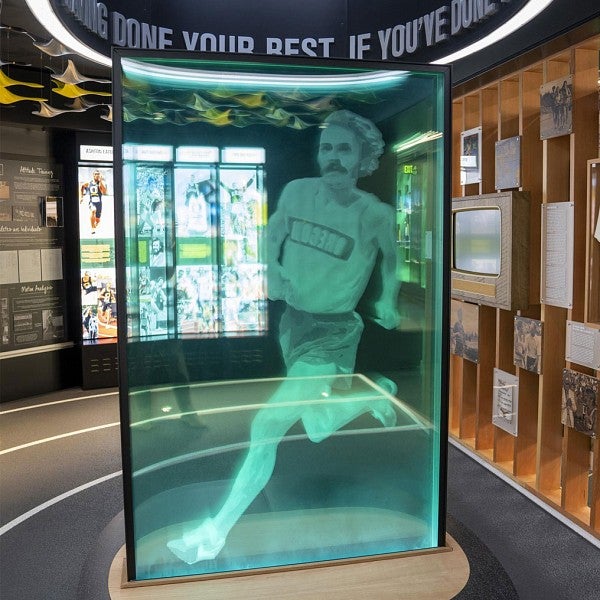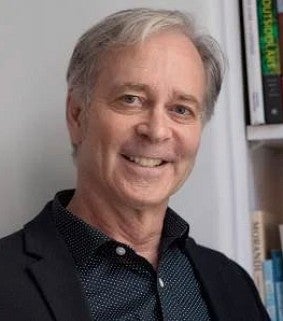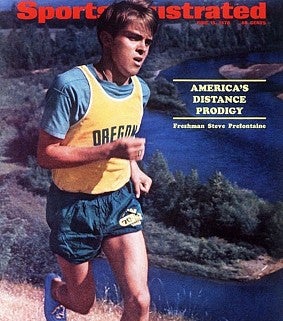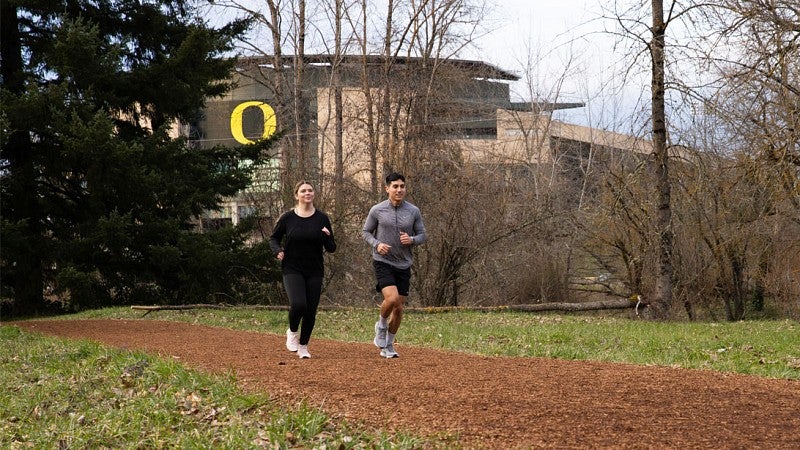
Experiential Learning | Research & Innovation | Community Impact | Career Preparation | Teaching Excellence | 21st Century Liberal Arts | Building Community | Good Vibes | CAS Spotlights | All Stories | Past Issues

April 26, 2024
The Power of Pre: One Scholar’s Explanation
Daniel Wojcik still remembers running with Steve Prefontaine in 1973, just two years before the University of Oregon track legend’s premature death in a car accident.
As a high school cross country runner, Wojcik was one of several students who got to join Prefontaine, aka Pre, for a morning run after an indoor track meet in Los Angeles. Like many other runners around the world, Wojcik admired the record-breaking athlete’s gutsy style and reputation for never holding back.
“We ran with him in almost complete silence, in awe of the supreme being of American distance running,” Wojcik recalls. “I was in college when Prefontaine died. I remember hearing the devastating news and then going to the campus cafeteria for breakfast, where there were other runners. We fell to our knees in sorrow.”

Now a professor of English and folklore studies in the College of Arts and Sciences, much of Wojcik’s research has focused on religious beliefs and practices, including pilgrimage and sacred places, and he has written about the lore and traditions surrounding the runner who helped establish Eugene as Track Town USA. As author of the paper “Pre’s Rock: Pilgrimage, Ritual, and Runners’ Traditions at the Roadside Shrine for Steve Prefontaine” and contributor to the documentary The Church of Pre by filmmakers Brian McLawhorn and Randolph Benson, he explores the enduring mystique of the man whose memory continues to draw runners from across the globe to participate in world-renowned races and competitive track and field meets at UO’s Hayward Field.
With the Prefontaine Classic coming up on May 25, 2024, Wojcik shares his thoughts about what makes Prefontaine a legend and why Eugene has become a haven for runners.
Why is Steve Prefontaine such an important running icon?

Prefontaine helped to make running “cool” and exciting. At the time of his death, Prefontaine was the most famous runner in the US and held every American track record from the 2,000-meter to 10,000-meter event. He is still the most popular long-distance runner associated with the UO, and he remains the most popular distance runner in American history, nearly 50 years after his death.
Prefontaine set 14 American records in his lifetime, and on the American running scene he appeared to be almost unbeatable, even superhuman, in the eyes of his fans. He was a fearless front-runner who punished his opponents with a brutal pace, and who often ran alone, against the clock and himself, to the point of complete exhaustion.
Prefontaine running at the UO for legendary coach Bill Bowerman, who co-founded Nike with Phil Knight, contributed greatly to the UO and Eugene building a reputation as a running haven. After him, a lot of people in organizations dedicated to the pursuit of running worked to establish Eugene as Track Town USA. This reputation and the university’s renowned facilities attract the best track and field competitors to UO.
Why does Prefontaine's legend endure?
His life has many of the features associated with other American folk heroes: He rose from the ranks of the common man; he was endowed with seemingly superhuman powers of physical strength and endurance; he had personal magnetism, exceptional vitality and lived life with gusto; he confronted the elite establishment; he performed feats of audacity and daring yet was good-natured and kind-hearted.
The legend of Prefontaine persists as the embodiment of courage, rebellion and the pursuit of one’s dreams with complete abandon. In his races he exhibited an almost martyr-like willingness to suffer for his goals, running through pain barriers into near oblivion. He believed his hard work and his devotion to a goal were more responsible for his success than any natural talent.

As an athlete dying young, the tragic ending of Prefontaine's life also has two important features of the classical “hero of tradition” pattern. The hero meets with a mysterious death, and he has one or more holy sepulchers, which for Prefontaine is Pre’s Rock, the roadside memorial that marks the place of his death in an automobile accident.
Prefontaine's approach to running has an enduring appeal, as he personified attitudes of dedication, courage and success—and ultimately tragedy, as an athlete in his prime, dying young.
For these reasons he has become a folk hero and icon of American running culture, and the memory of him is forever connected and infused into the city and landscape of Eugene.
Why are traditions important in running? What are some of the running traditions in the Eugene area that trace back to Prefontaine?
Every sport has traditions, as these are part of every human endeavor that involves social groups and interactions. Traditions help form a sense of community and identity and create a bond between people. They teach others about appropriate and inappropriate actions specific to a particular group.
Perhaps the most well-known tradition relating to Prefontaine is visiting Pre’s Rock, a monument located on Skyline Boulevard at the site of his car crash. Runners and fans from all over the world visit it to pay their respects. People frequently leave personal objects that are symbolically connected to Prefontaine and the broader subcultures of distance running and track and field. The things left there include running shoes, race medals, trophies, race bib-numbers, T-shirts, ribbons and jerseys.
What lessons can aspiring runners take from Prefontaine and the strong track community at University of Oregon?
Prefontaine never gave up, he went all out, and he worked incredibly hard to achieve his goals. And as he once said, “To give anything less than your best is to sacrifice the gift.”
—Jenny Brooks is a communications coordinator for the College of Arts and Sciences.
What Makes Eugene a Great Running Town?
Eugene is a town that supports running and provides a welcoming vibe for runners. I think we sometimes forget how ideal things are here for runners with such a wonderful running community. Some of my old running buddies remind me of this when they visit me, with some jealousy, about the extraordinary running culture we have here in Eugene, a community that is accessible and friendly.

For example, we have:
- Top-caliber world-class track and field competitions here, as well as summer all-comers meets that are put on by the Oregon Track Club for children and teens and really anyone who wants to participate.
- Excellent specialty running stores that offer weekly fun running events and there are other free public events related to running offered by UO, OTC and other groups.
- Sporthill clothing, a company located in Eugene, founded by former world-class UO runner Jim Hill.
- Local road races every month, as well as the Butte-to-Butte 10K held every July 4. In fact, this summer is the 50th anniversary of the race.
- Tens of thousands of runners participate in road races that have been held for decades here, with thousands coming to Eugene every year to race and enjoy this running paradise. Running enthusiasts throughout the US, and globally, participate in the popular Eugene Marathon and its corresponding half-marathon and 5K which came on the scene in 2007. The 2024 event had more than 12,000 participants.
- The 2024 US Olympic Team Trials for Track & Field are coming to Eugene this June. Eugene has hosted the event more than any other place in the US.
The city has invested in building a running environment for every kind of runner, from Olympic athletes to everyday joggers, with many places to run. Some of my local favorites are:
- The Prefontaine Memorial Trail in Alton Baker Park, inspired by Prefontaine’s running on bark, chip and dirt trails in Europe.
- The five-and-a-half mile Amazon Trail in southeast Eugene.
- The Ridgeline Trail, which extends for more than 12 miles through the mountain landscape, Douglas fir forests, and hilltops just south of Eugene.
- The UO campus along with the Pioneer Cemetery.
- The trails of Hendricks Park south of UO’s campus.
—Daniel Wojcik is a Fulbright Scholar and professor of English and folklore studies in the College of Arts and Sciences.
